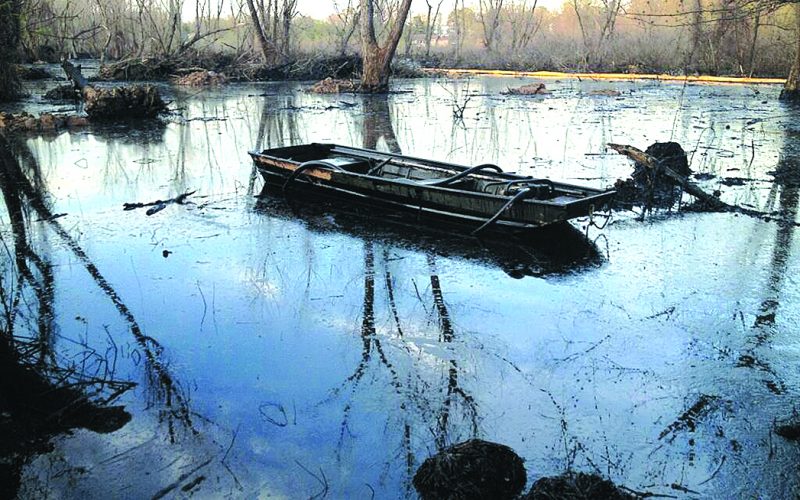
Photo By Terrah Baker
Exxon officials stand with local law enforcement behind a blocked off area of Lake Conway, where workers could be seen spraying oil in the streams with fire hoses, moving it around to a single location to be sucked up. Exxon officials were all over the area and coordinating check points with local law enforcement in order to keep out citizens and media.
By Terrah Baker
The first night of the oil spill on March 29, the small Arkansas town of Mayflower looked like the scene of a UFO crash, said Mayflower resident Kelly Paige. Exxon and the U.S. government had response crews on scene that night, complete with an army of private and public employees that was still there the day TFW came to town.
One Fayetteville resident driving through Conway the following day, March 30, said the strong smell crept onto the highway and made their eyes water and their head hurt. Meanwhile, right next to the spill, Paige, her brother and disabled father waited in their mobile home to hear what was going on.
“They haven’t said anything to us. We had city employees in our backyard trying to get pictures because they wouldn’t let the cops in the other way,” she said.
They, being Exxon and its affiliates who are allowed to take over the right-of-ways the pipeline runs through. She said her family could barely breathe and in their homes the smell lingered, like it was sticking to everything. They were nauseous and couldn’t eat their Easter dinner two days later.
For many Mayflower residents, that first night was when they were taken out of their homes. Not for Paige and her family. But they don’t live in the Northwoods subdivision where the mayor and others do. They live in the trailer park next to it, on land their family has owned for over 100 years.

Photo Submitted
Investigations by citizen environmental groups showed locations of wetland where Exxon was dumping collected oil. Initial rumors were that Lake Conway was not contaminated, but later pictures and evidence proved otherwise.
Mayflower still smelled the day TFW visited — four days later on April 3 — but only when close to the streams where much of the oil now sits. A man from the Arkansas Department of Environmental Quality (ADEQ) held up an air quality tester as he stood by a stream that ran through town. It was clear the stream was still highly contaminated as the thick tar sands oil floated throughout and the shorelines were stained black; but the air was not anymore, the man said.
He wasn’t allowed to disclose the chemicals that had been leaching into the public air the last four days because of protective orders given to oil companies by the U.S. government, but they were almost all gone, he assured.
When the pipe first blew, air contamination by benzine and other undisclosed chemicals were high, to which residents can attest, but no one seems to know just how high. Even the local police officer that pulled over TFW group for questioning said he didn’t remember warnings of air contamination following the spill.
Now, all residents want is the oil to be cleaned up, Paige and her family said. They want to be able to walk to the back of their property and not see and smell the tar sands oil (bitumen).
Sadly, that’s all most people want after a crude and tar sands oil spill, which have been happening around the world since pipelines began — more than 12 in the U.S. alone, with a minimum of 10,000 tons of oil spilled in each occurrence since 1901, and the highest at over 1.2 million tons in 1909 on the coast of California. Unlike many of the past, news organizations, scientists, activists and residents point out how different this spill really is.
Many have discussed the tax exempt nature of tar sands oil because the law that requires oil companies pay into a reserve in case of spills only applies to a certain type of crude. Others explain that tar sands oil is strip-mined from the Boreal Forest in Canada, processed using millions of gallons of water that is then turned to toxic waste in unlined holding ponds and because of its thick, toxic nature poses whole new problems for clean up.
But Mayflower residents don’t have to wait to see what their lakes and waterways will be like years from now. There are enough examples of tar sands oil spills, like that of the Kalamazoo River that was widely underreported, and has been named one of the nation’s costliest. Three years later, a 60-mile stretch of the Kalamazoo is still left mainly uninhabited and largely contaminated with sunken tar sands oil.
While the Mayflower police officer told us he has complete faith in Exxon — after he explained he pulled us over due to concern about protesters, despite us not having breached a restricted area — new reports are released every day with proof of Exxon’s mismanagement of oil and power.
“I’ve been able to speak with them first-hand so believe they’re going to do what they say they’re going to do,” the officer said.
From the looks of the town and the level of security, there’s no doubt that he’s talked with Exxon officials, as they were all over the area, behind the lines where private citizens and media and even local law enforcement have been banned.
After visiting the spill, the sticky truth is: oil isn’t cleaned up. It’s pushed around, forgotten about and in the end, left for residents, state and local governments, and nature to deal with. In the meantime, oil companies like TransCanada and Exxon have local, state and federal officials on their side, and in their back pocket.
Photos Taken by TFW: http://www.flickr.com/photos/thefreekly/sets/72157633165472672/
Photos Taken by the EPA On-Scene Coordinator: http://epaosc.org/site/image_list.aspx?site_id=8502










